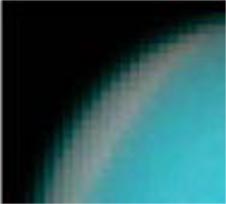|

Your eyes are amazing visible light detectors. The dark-adapted
eye is so sensitive it can detect a single photon! There are instruments
that can also detect a single photon, used in telescopes to detect and measure
the visible spectra from stars and other luminous bodies in space. These
detectors convert light energy into digital information that can be transmitted
from orbiting spacecraft back to earth. The incredible photographs obtained
by the Hubble Space Telescope are examples of digital images transmitted
to earth and processed by computers.

|
Learn how to make your very own spectroscope, similar to the
instrument used on the Hubble Telescope to measure the light coming from
distant stars!
|
|
|
There are two versions of this activity. Specify
your browser:


|
|
-
When you have finished building your spectroscope, you
may look at the continuous spectra of light bulbs and fluorescent lights.
Is there any difference in their spectra?
You may also use your spectroscope to look at neon signs,
sodium vapor lights, and mercury vapor lights. Is there any difference
between these spectra and those from light bulbs?
-
If your school has gas vapor lamps containing hydrogen,
helium, neon, or argon, you may use your spectroscope to observe the emission
line spectra of these gases. Why are the spectra of these gases not continuous
like the spectra of a light bulb or the sun?
-
You may be able to use your spectroscope to observe the
dark lines in the solar spectrum. BE CAREFUL! Do not look directly at the
sun! The dark lines in the solar spectrum result from the absorption of
some of the sun's visible light by the gases of the earth's atmosphere.
-
A down-to-earth example of a Charge Coupled Device (CCD)
that is used to gather light in digital form is a digital camera. This
type of camera oprerates in the same way as an ordinary camera except that
is has no film. Light is gathered on screen of a CCD and transferred to
a digital memory in the camera. When the digital memory is downloaded into
a computer, the image can be seen and printed. If you have access to one
these cameras, you can see how images are collected by modern telescopes.
|
|
If possible, enlarge an image from a digital camera on a computer
screen. As the image enlarges, you will begin to see little squares called
pixels. Pixels are the units of digital images and they are usually too
small to be noticed, but the images of distant objects recorded by the Hubble
Space Telescope often show the pixels.
|

|
This close-up view of a portion of Neptune clearly shows the
pixels that make up the digital image.
|
|

©1997 The
Exploratorium
|